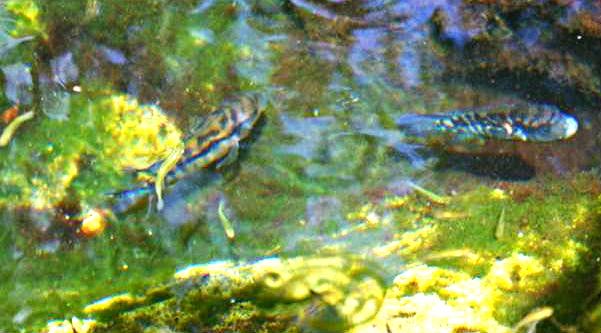Below is a repost of mine that demonstrates how different the optimum frequency of feeding can be among different species of fish.
Just keep in mind that how much one feeds, can be just as important as how often. Both how much and how often one should feed is a tricky question, dependant on the species of fish, their typical activity level, and even more important their life stage. I feed adults once a day, and skip feeding on water change days. So no more than 5-6 times a week. When I was actively breeding, fry and young juvies generally were fed 2-3 times a day due to having higher metabolic rates, so their feeding frequency was different than adults of the same species.
In a past discussion on "how often" one should feed I posted a few links to scientific papers that demonstrates how different the optimum frequency of feeding can be among different species of fish.
Most tropical species have yet to be studied for optimum nutrition vs growth, or for that matter anything. Long term studies for the vast majority of tropical species simply don't exist, but common sense and experience over the years dictate that clean unpolluted water with proper 02 levels, quality and correct quantity of nutrients, and an overall low stress environment is always the best avenue to maximize the genetics of any individual fish.
As far as feeding, it's a complicated subject. From a paper that I read a few years back...….
The initial observations in the present study did not detect further growth responses (on percent basis). In the present study the higher body weight was observed in fish fed to a frequency of two times per day. Similar results were observed by James and Sampath [26] in Red Swordtail (Xiphophorus helleri) which indicated that feeding twice a day resulted in the highest growth and reproductive success of this specie in a cultured system, when compared with 4 alternative feeding regimens (once, thrice, once and twice a day). James and Sampath [26] had similar findings in Siamese fighting fish (Betta splendens. Regan) who showed that fish fed twice a day to satiation elicited maximum growth and reproductive output when compared with its counterparts (1 meal in 3 d, 1 meal in 2 d, 1 meal/d, and 3 meals/d). Contrary to our results commercially cultured fish species such as Black Rockfish (Sebastes schlegeli) suggested that feeding to satiation once a day resulted in optimum growth [27]. Gibel Carp (Carrassius auratus gibelio), showed a significant surge in growth rate and feed efficiency when feeding frequency increased from 2 to 3, 4, 12, and 24 feedings per day, with the recommendation of 24 feeding times per day for this species [15]. The difference in results might be due to the fact that goldsh is not usually reared for commercial purpose. Moreover, this fact also leads to the fact that there is a need to improve the genetic potential of goldfish if we want to rear it for commercial reasons. In the present study, the maximum weight gain was observed in the feed (B) and the same result was observed in Siamese fighting fish (Betta splendens. Regan) which showed that 2 meals per day fed to satiation are sufficient to support the maximum growth. Further it has been reported that ornamental Red Swordtail (Xiphophorus helleri) fed 2 meals per day resulted in the greatest growth [28]. But contrary to present study the juvenile Atlantic Halibut (Hippoglossus hippoglossus) displayed improved growth rates when fed on satiation 5 times per day, compared with one time per day [29], and African Cafish (Clarias gariepinus) exhibited greater growth rates when fed to satiation twice compared with 3 times per day [30]. In the present study the better feed conversion ratio (FCR) was observed in Feed (A) but contrary to present study best FCR were observed for the Goldfish fed 4 times per day, indicating that this frequency of feeding was optimal, suggesting that both growth and feed utilization are more efficient at this feeding frequency [31].
PDF | Influence of Feeding Frequency on Growth performance and Body Indices of Goldfish (Carrassius auratus). Available from:
https://www.researchgate.net/public...d_Body_Indices_of_Goldfish_Carrassius_auratus [accessed Jul 11 2018].







